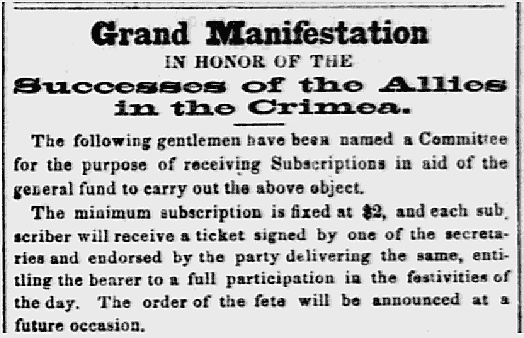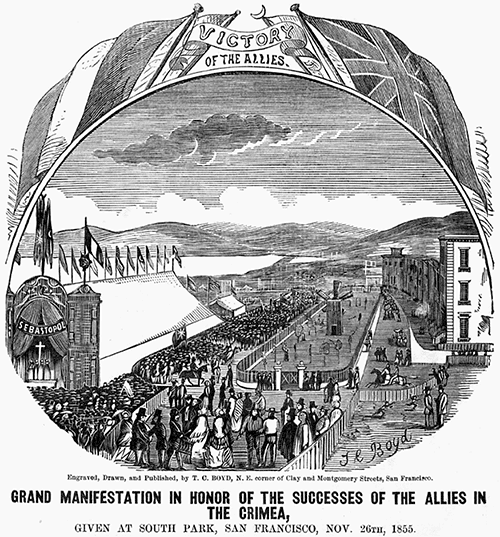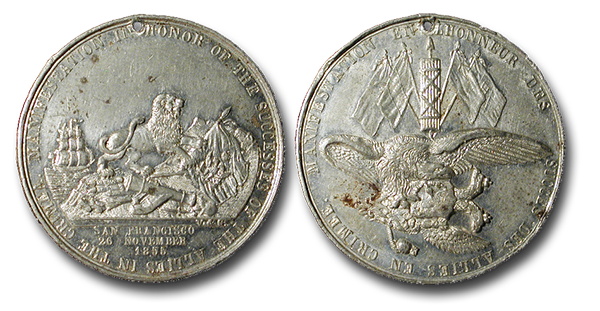The Crimea War Medal of San Francisco
by Michael Wehner
2020 First Place
The Crimean War (1853-1856) is not something that most of us would have learned much about in high school history. Like all wars, it was a tragic series of events with causes and outcomes that seem irrelevant or even petty today. Ostensibly driven by religious differences between the Roman Catholic and Orthodox faiths, it was really about perceived power and influence of the major European powers. In a nutshell, the allied British and French powers did not want Russia to gain territory and power as the Ottoman empire declined. Not natural allies, the French, British, Sardinian (part of modern Italy) and Turkish troops eventually prevailed over the Russians. Although not yet a fully mechanized conflict, munitions technology had advanced the art of killing to unprecedented levels. This, combined with an unusually high amount of ineptitude on the part of the Allied commanders, made this conflict extremely unpopular at home, particularly in Great Britain. Alfred, Lord Tennsyon in his poem The Charge of the Light Brigade evokes the fate of the foot soldier and the incompetence of their commanders:
“Forward, the Light Brigade!”
Was there a man dismayed?
Not though the soldier knew
Someone had blundered.
Theirs not to make reply,
Theirs not to reason why,
Theirs but to do and die.
Into the valley of Death
Rode the six hundred.
The Gold Rush of 1849 brought people from all over the world to California. This amalgam of different backgrounds and cultures laid the foundation for the marvelous diversity that is our state today. Many of these “Argonauts” were from Great Britain, France and Italy. And while the horrors of war and the substantial Allied casualties lead to unpopularity at home, in California the story was told differently, at least in the Daily Alta California, where the newspaper’s editorial slant was decidedly aligned with the British and French sides.
In October 1854, British, French and Turkish troops began a lengthy siege of the port city of Sevastapol. Strategically located on the southern part of the Crimean peninsula, the siege was lengthy and costly to all sides. It would not be until September 9, 1855 that the Russian city would fall to the allies. Weary of war, the parties signed the Treaty of Paris on March 30, 1856 ending the conflict and returning the allied occupied territories to Russia.
Back in California, world news arrived slowly. It was not until October 30, 1855 that the steamship Sonora arrived in San Francisco from Panama with the news of the fall of Sevastapol. Reprinting accounts from the British, French and Russian sides, the news was received in San Francisco with great joy. So much joy in fact that a massive celebration “to celebrate the triumph of the Allies in the taking of Sebastopol” was announced in the November 6th edition of the Daily Alta California. Tickets to a “Grand Manifestation” were to be $2 with proceeds going to the widows and children of soldiers who had lost their lives in the war.

Announcement of the “Grand Manifestation” in the Daily Alta California. [San Francisco Maritime National Historical Park (A11.19,318n) via the FoundSF website]
The date chosen for the fete was Monday November 26, beginning with a parade at 2nd and Market Streets in San Francisco. A large tent, measuring 227 feet long and 104 feet wide was constructed at South Park with five long tables to accommodate the banquet. Demand for tickets was high, thus the admission price was raised to $5.

Lettersheet of T.C. Boyd depicting the Crimean war celebration that is mentioned the following day in the report of the Daily Alta California. South Park is still part of San Francisco today and is a quiet little neighborhood.
So on the warm and beautiful day of the celebration, 5000 San Franciscans gathered to parade around, listen to patriotic speeches and music and enjoy the feast. What could go wrong?
The Daily Alta California on November 27 details the success of the party and extols what a grand time was had by all:
“It was purely Californian, and as such, should be noticed by those who participated in it.”
But the newspaper also contains an apology from the organizers for the “untoward occurrence which compelled them to break up the banquet”. What could this untoward occurrence be? Well, you must remember that this was 1855 San Francisco and that most of the partiers were young men. And also that vast quantities of English ale and French wine were consumed. The newspaper goes on to report:
“A general scramble ensued around this arena of confectionary, from which our reporter escaped with great difficulty. At the same time the air became filled with showers of biscuit and loaves of bread pelted from all directions. This novel bombardment was kept up for some time, and seemed to be participated in by the representatives of all nations. As a sort of variation to this performance, a trussed turkey or roast crackling might be seen describing erratic courses across the pavilion. Greasy pieces of pork came in violent contact with bald uncovered pates, the flying edibles being in some instances caught in their career, and the missiles returned in like manner with an unction truly refreshing. All this, however, was given and received in good part. Wine flowed freely…”
In other words, they had a food fight. Amidst all this fun, someone was selling souvenirs.

Obverse: MANIFESTATION IN HONOR OF THE SUCCESSES OF THE ALLIES IN THE CRIMEA / (the British lion trampling the Russian Imperial flag and instruments of war / sailing ship in background) / SAN FRANCISCO / 26 NOVEMBER / 1855
Reverse: MANIFESTATION EN HONNEUR DES SUCCES DES ALLIES EN CRIMEE / (French fasces with phrygian cap, flags of the four allies, Great Britain, France, Sardinia, Turkey / an eagle trampling the Russian Imperial two headed eagle) White metal, 38mm
This medal commemorating this Grand Manifestation, often but not always, is holed for suspension for use as a badge. In English on one side and French on the other, it is signed “V&G” on the obverse.
The imagery illustrates the victorious allies crushing the Russian Empire. “V&G” is the signature of Achille Vachon and Marc Giron, partners in San Francisco, who arrived in San Francisco by 1852. In our research of the 1861 California Union medal, Bill Hyder and I learned that both partners tragically drowned on June 21, 1858 in British Columbia while being ferried to a steamship.
The only other documented medal by Vachon and Giron is the more famous 1856 membership badge for the Second Committee of Vigilance in San Francisco. But this medal for the Crimean war victory celebration in San Francisco has the distinction of being the first commemorative medal to be designed and manufactured in California.
The Crimean War medal is likely as rare as the Vigilance medal. It appears several times in early auction records only as white metal and a few have surfaced recently. At the 18th meeting of the Pacific Coast Numismatic Society in October 1916, a Mr. A. Reimers exhibited an uncirculated gold example. He believed it to be unique and to have been presented to Mrs. George Gordon by the event organizers as her husband was the developer of South Park. Its present status is unknown.
Vachon and Giron’s medal is a remembrance of a party in San Francisco celebrating the conquering of a distant city by foreign powers in a war without any direct connection to California. To modern observers, the event seems to be more in the spirit of a sporting event victory celebration. Perhaps a Rose Bowl or similar championship. One wonders if, in their exhuberance, the celebrants reflected on the consequences of the Crimean war.
Sources
California Digital Newspaper Collection at https://cdnc.ucr.edu
Daily Alta California, Volume 6, Number 269, 30 October 1855
Daily Alta California, Volume 6, Number 276, 6 November 1855
Daily Alta California, Volume 6, Number 295, 25 November 1855
Daily Alta California, Volume 6, Number 297, 27 November 1855
Daily Alta California, Volume 10, Number 176, 28 June 1858
Illustrated London News. Saturday 16 February 1856
https://www.britishnewspaperarchive.co.uk/
https://en.wikipedia.org/wiki/Crimean_War
https://en.wikipedia.org/wiki/Siege_of_Sevastopol_(1854-1855)
https://www.poetryfoundation.org/poems/45319/the-charge-of-the-light-brigade
FoundSF. “Early Development Around Mission Bay, 1850–1857”
http://www.foundsf.org
L. Leland Steinman. “Pacific Coast Numismatic Society.” The Numismatist Vol. 29 (1916), No. 12, pp 562-563. (Thank you to John Kraljevich for pointing to this.)
William Hyder and Michael Wehner. “Resurrecting a Symbol of Vigilance: The 1861 California Union Medal.” The Numismatist. Vol. 131 (2018), No. 12, pp 30-39.